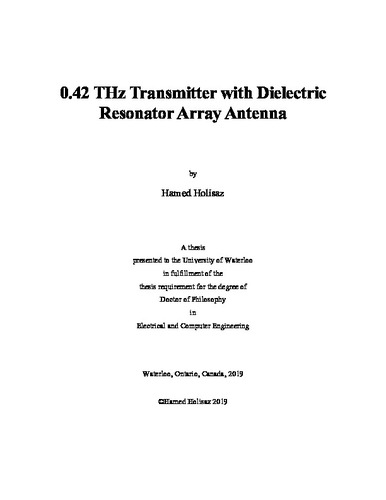| dc.contributor.author | Holisaz, Hamed | |
| dc.date.accessioned | 2019-07-23 18:55:11 (GMT) | |
| dc.date.available | 2019-07-23 18:55:11 (GMT) | |
| dc.date.issued | 2019-07-23 | |
| dc.date.submitted | 2019-04-11 | |
| dc.identifier.uri | http://hdl.handle.net/10012/14819 | |
| dc.description.abstract | Off chip antennas do not occupy the expensive die area, as there is no limitation on their
building material, and can be built in any size and shape to match the system requirements, which
are all in contrast to on-chip antenna solutions. However, integration of off-chip antennas with
Monolithic-Microwave-Integrated Chips (MMIC) and designing a low loss signal transmission
from the signal source inside the MMIC to the antenna module is a major challenge and trade off.
High resistivity silicon (HRS), is a low cost and extremely low loss material at sub-THz. It has
become a prevailing material in fabrication of passive components for THz applications. This work
makes use of HRS to build an off-chip Dielectric Resonator Antenna Array Module (DRAAM) to
realize a highly efficient transmitter at 420 GHz. This work proposes novel techniques and
solutions for design and integration of DRRAM with MMIC as the signal source. A proposed
scalable 4×4 antenna structure aligns DRRAM on top of MMIC within 2 μm accuracy through an
effortless assembly procedure. DRAAM shows 15.8 dB broadside gain and 0.85 efficiency.
DRAs in the DRAAM are differentially excited through aperture coupling. Differential
excitation not only inherently provides a mechanism to deliver more power to the antenna, it also
removes the additional loss of extra balluns when outputs are differential inside MMIC. In
addition, this work proposes a technique to double the radiation power from each DRA. Same
radiating mode at 0.42 THz inside every DRA is excited through two separate differential sources.
This approach provides an almost loss-less power combining mechanism inside DRA. Two
140_GHz oscillators followed by triplers drive each DRA in the demonstrated 4×4 antenna array.
Each oscillator generates 7.2 dBm output power at 140 GHz with -83 dBc/Hz phase noise at 100
KHz and consumes 25 mW of power. An oscillator is followed by a tripler that generates -8 dBm
output power at 420 GHz. Oscillator and tripler circuits use a smart layer stack up arrangement for
their passive elements where the top metal layer of the die is grounded to comply with the planned
integration arrangement. This work shows a novel circuit topology for exciting the antenna
element which creates the feed element part of the tuned load for the tripler circuit, therefore
eliminates the loss of the transition component, and maximizes the output power delivered to the
antenna. The final structure is composed of 32 injection locked oscillators and drives a 4×4
DRAAM achieves 22.8 dBm EIRP. | en |
| dc.language.iso | en | en |
| dc.publisher | University of Waterloo | en |
| dc.subject | THz | en |
| dc.subject | Antenna | en |
| dc.subject | DRA | en |
| dc.subject | Array | en |
| dc.subject | mmWave | en |
| dc.subject | Tripler | en |
| dc.subject | RF | en |
| dc.subject | Analog | en |
| dc.title | 0.42 THz Transmitter with Dielectric Resonator Array Antenna | en |
| dc.type | Doctoral Thesis | en |
| dc.pending | false | |
| uws-etd.degree.department | Electrical and Computer Engineering | en |
| uws-etd.degree.discipline | Electrical and Computer Engineering | en |
| uws-etd.degree.grantor | University of Waterloo | en |
| uws-etd.degree | Doctor of Philosophy | en |
| uws.contributor.advisor | Safavi-Naeini, Safieddin | |
| uws.contributor.affiliation1 | Faculty of Engineering | en |
| uws.published.city | Waterloo | en |
| uws.published.country | Canada | en |
| uws.published.province | Ontario | en |
| uws.typeOfResource | Text | en |
| uws.peerReviewStatus | Unreviewed | en |
| uws.scholarLevel | Graduate | en |

